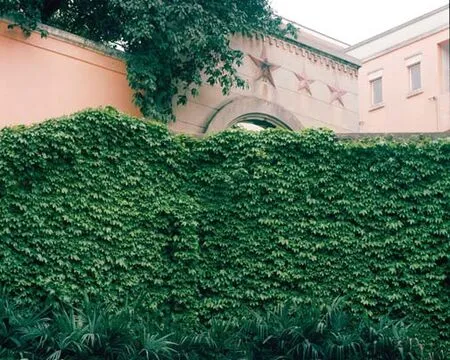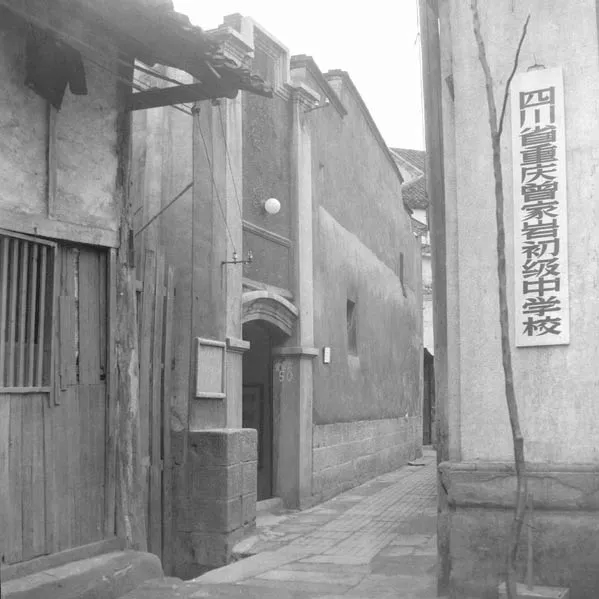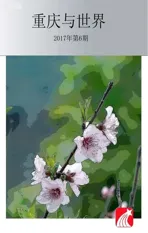百年上清寺 重庆的“大脑中枢”
2017-07-31杨艳
□ 文/本刊记者 杨艳
百年上清寺 重庆的“大脑中枢”
□ 文/本刊记者 杨艳
罕见老照片再现影像展
上清寺,重庆人每天穿梭于这里,公交车内播报着这个站名,但关于它的由来,有些重庆人似乎却从不知晓。重庆文史专家肖能铸曾是小说《失踪的上清寺》的文史顾问,他介绍,上清寺因一座寺庙而得名,随着时间流逝,这座寺庙早已不在,如今只留下一个地名,让后人怀念。“曾经的上清寺有大片田土、丘陵,在明朝嘉靖年间,就在今天的天坛新村与重庆医科大学附属口腔医院的位置,确实有一座雄伟的寺庙,香火鼎盛。”肖老说,寺庙延伸到嘉陵江边,由于地理位置优越,船舶停靠方便,许多客商便来到这里安营扎寨,开始在此销售生活物资,这里逐渐形成了一个天然的集市口岸,来往的人越来越多,便日益繁盛起来,后来人们就用“上清寺”作为这一带的总称,人人皆知。

戴笠公馆。
晨曦初露,紫霭升腾浸润浅蓝色的天幕,路灯照亮静谧的中山四路,成群的小鸟在枝头展开翅膀,九园的包子在蒸笼里冒着热气,求精中学的晨读铃声响起,教室里传来朗朗读书声,文化宫里晨练的老人伸展着腰背,一列列轻轨在牛角沱纵横交错,划开城市的寂静,这就是今天的上清寺的清晨,附近的市民每天在幽静的环境中醒来,开始新的一天……
曾经,一个个故事在上清寺一带上演,现在已成为重庆人茶余饭后的谈资。因为它在这座城市里的特殊性,一场《百年上清寺》影像展于4月26日—5月14日,在上清寺中山四路展出,这场展出重拾了山城人民对上清寺的浓厚回忆和特殊情感。
据上清寺街道党工委书记艾正兵介绍,此次展览图片搜集历时多年,分别来自美国生活杂志社、英国布里斯托大学、瑞士摄影基金会、盖蒂图片社等国际国片机构;中国邮政、重庆中国三峡博物馆、重庆市设计院等市级公立机构;以及民间收藏家的收藏。数百幅摄影图片,最早可追溯到19世纪于重庆开埠时期的照片,还找寻到散落在海外的几近丢失的图片。这些不同时期的建筑和环境景观让人们看到了上清寺在时代变迁下的一次又一次“变脸”。
“对于重庆老百姓来说,虽然我们常有路过,但少有驻足之时,所以上清寺可以说是一个既熟悉又陌生的地方。这次展览就让我们将上清寺的记忆进行一次彻底的梳理,通过图片影像勾勒出这一带发展的清晰脉络。”策展人王远凌告诉记者,若将现在上清寺的区域规划与以往作对比,严格来说,现在的上清寺其范围相对较窄,所以此次展览主要纪录了早期规划的上清寺片区。
“上清寺萌芽于开埠时期的西方教会的聚集,诞生于潘文华第一次拓城,兴起于陪都时期国民政府迁址于此,解放后,西南军政委员会的设立再次确立了上清寺作为‘重庆大脑’的历史地位,围绕着上清寺地区,逐渐修建起重庆市人民大礼堂、重庆市劳动人民文化宫和大田湾体育场三大主体建筑。”王远凌说,整个展览尽管讲述的是上清寺一带,但我们从中可以看到一条浓缩的城市变迁之路。
看老图片寻身边古迹
上清寺,东邻大溪沟街道,南接两路口街道,西接大坪街道,北面嘉陵江,上清寺境内街巷繁多,阡陌纵横。这里有重庆主城区主要交通干道人民路、中山三路、中山四路、上清寺路、嘉陵桥路,上清寺的中心便是这数条干道的交汇处,所有故事仿佛就从此处展开,所有重要建筑围绕它而扩散建造。然而,它是熟悉的,又是陌生的,它曾演绎了怎样的故事,我们或许知道得太少。
“上清寺不止一百年历史,我们在上清寺还能见到更早时期的印记,比如曾家岩19号就是最好的证明。”在肖能铸的指引下,记者来到上曾家岩19号,这里与曾家岩50号的周公馆仅有一墙之隔,这是一栋庄严朴实的建筑,黑色斑驳的大门上方清楚地刻着“从善如流”4个大字,石门古风古色,乃清代旧物。肖老说:“这里在清代是一个书院,相当于私塾,后来房屋卖给了一个外国人,然后再辗转到中国人手里,由于数位主人的更替,房子经过不同时期的改造就留下不少中西式结合的建筑元素。”旧时光给这栋房屋留下不同的印记,传统的民居气息渗透着海派的韵味,室内雕有大马士革花纹,也有中式的装饰痕迹,幸运的是此建筑的石门保持了初建时的模样,观之如忆当年。
在牛角沱嘉陵江大桥下的江畔,一个约4层楼高,宽约11米的硕大石头格外醒目,重庆人在嘉陵江边来来往往,殊不知这块看似寻常的石头却是一件珍贵文物。它形似古代官帽,所以取名“纱帽石”,石头上镌刻着“董公死难处”5个大字,大字面朝江面,在江对岸才能看清。据肖老介绍,董公是明代万历年间一位举人,名叫董尽伦,在1621年奢崇明叛乱之时,他倾资募兵,率子弟平叛乱而殉国于重庆,后人将“董公死难处”刻于这块石头上,以此纪念壮烈殉国的董尽伦,纱帽石由此得名,当地人又称表忠石,“石头上还留有乾隆、光绪年等题刻,有的是吊唁董尽伦,有的是祈求董尽伦的保佑,以前还能看到‘长命’‘富贵’之类的文字,可惜因为风化严重,现在已难寻踪迹。”

位于嘉陵江边的纱帽石。
信息中枢 公馆林立
上清寺的兴盛始于潘文华第一次拓城。民国时期,那时的渝中区母城,放眼望去,满城皆是三尺多宽的狭长步道,滑竿通行方便,但车辆通行十分不便,面对这样的情景,当时重庆第一任市长潘文华当机立断,大修公路,他亲自规划了主城三条公路,以渝中半岛山脊为界,分中区干线、南区干线(沿长江)和北区干线(沿嘉陵江),由七星岗经两路口、上清寺到曾家岩的中区干线,就是著名的中山大道,路面增宽了,通行车辆不再成问题,完工后就取名为中山路,并把它划分为4段,上清寺是最后完成的,取名中山四路。
上清寺一带在抗战时期成为全国指挥中心,在无线通讯方面增设了快机报房,并首次开通英、美、苏、印等国的国际电路15条,开办了国际传真和特快电报新业务。当年,无数信息从上清寺发出或发回,上清寺就像“大脑中枢”,处理着来自世界各地的信息。
“1935年,重庆市设5区22坊,上清寺就属于其中的第三区,当时的上清寺地区就相当于一个新区,因此修建了很多精致的小洋楼和公馆,成为典型的名流聚居地。”王远凌说,当时这一带的繁华区域逐渐由两江沿岸向新建公路两侧转移。抗战时期,上清寺成为国民政府战时首都的政府机关驻地,因此而闻名中外。抗战胜利后,著名的国共两党“重庆谈判”在此进行,后来这里成为中共中央西南局驻地。毛泽东、周恩来、邓小平、蒋介石、马歇尔等一大批中外名人在此留下足迹,也就有了我们熟悉的桂园、怡园、美龄楼、周公馆、范公馆、戴笠公馆等民国名人公馆与故居。中山文化产业园总经理张直说:“中山四路承载着整个中国近现代重要的历史和文化事件的记忆,这条街道上一大批文化遗存全部原貌保留下来,非常罕见。”多年来,中外游客、历史爱好者纷至沓来,探寻历史的遗迹。
名校云集 重庆现代教育的开端
从1937年的《国民公报》重庆市街道图上,我们能够看到上清寺的街道格局,这里曾是有名的学区,西南美专、重庆市人民小学、曾家岩中学等都在这里汇集。
重庆求精中学退休老师曾祖才曾在求精中学读书6年,后来回到求精中学工作了30多年,退休后又返聘回校工作,在求精中学待了长达58年之久,对求精中学的前世今生十分了解:“求精中学创办于1891年,当年美国教会有一个牧师叫路易斯,他想在重庆创办一所教会学校,传播西方文化,于是在曾家岩买下张氏兄弟的400亩土地作为办学场所,取名为‘求精学堂’,他任第一任堂主,求精中学就这样诞生了,这是重庆第一所中学。学校办学一百多年来,为国家培养了大批人才,比如开国元帅刘伯承、国画大师张大千,还有全世界闻名的水稻专家袁隆平……抗战期间,宋美龄领导的战时儿童保育会就设在校内。”

特园。

① 早年的求精中学。(图片由重庆中国三峡博物馆提供)

② 重庆市人民小学。

③ 早年的文化宫春秋有花展,夏天可游泳,冬天有灯会,一年四季开展丰富活动。
早年这附近有不少教会学校,1897年,由美国基督教美以美会女布道会在曾家岩创办淑德女子学堂。附近还有由法国圣母小昆仲会创办的明诚中学。1928年,天主教重庆教区在曾家岩长十二间街创立的明德初级小学。
在上清寺,似乎每一座学校都曾有说不完的过去,比如重庆市人民小学的前身是晋冀鲁豫军区干部子弟校,随刘邓大军南下落户上清寺,刘伯承元帅为学校命名并题写校训,邓小平同志的夫人卓琳女士任首任校长,贺龙元帅任首任董事长,1997年学校正式更名为重庆市人民小学。
在这里不得不提的还有赫赫有名的美专校街,因一所学校而得名的街道。西南美术专门学校,又名西南美专,因建街辟市,故街道取名“美专校街”,一直沿用至今。它北接上清寺,东连中山三路,沥青路面,现在车水马龙,十分热闹。1926年,杨公庹筹集资金,在张家花园创办了“西南美专”,他自任校长。西南美专是重庆最早的美术学府,抗战时期,国画家张聿光、音乐家沙梅、刘淑芳等名家都曾在西南美专执教,那时的西南美专可谓桃李满园竞芳菲。正是这些早年创立的学校成为了重庆现代教育的开端。
人民的文化精神乐园
我们在展览上能看到不少重庆市劳动人民文化宫(简称“文化宫”)的老图片,这里可谓是重庆人民的精神乐园。文化宫的大门就如一扇穿越时间的门廊,走进重庆人民群众精神文化建设与发展的历史。
(图片由彭世良提供)
解放后,中国经济发展刚刚起步,广大人民群众的精神文化生活十分贫瘠。在此背景下,时任西南局书记的邓小平同志提议修建重庆市劳动人民文化宫,他在提议中说道:“重庆解放了,人民生活改善了,打上了肉牙祭,这还不够,还要让人民打上精神牙祭。”于是,1952年8月竣工的文化宫一下子打开了山城人民群众丰富的精神文化生活。随着扩建,文化宫逐渐开设了文化广场、灯光球场、游泳池、露天剧场,成为文化服务功能丰富、环境优美的群众文化娱乐活动中心场所。“春天有花展,夏天可以游泳,秋天菊花展,冬天还可以游园,这是孩子们一年四季都可以玩的游乐中心。”曾在求精中学就读的王远凌说文化宫就曾陪伴他成长。从清晨到傍晚,这里的人络绎不绝,打太极拳、跳健身操、下棋、练毛笔字……每逢重大节日,文化宫内还会举行形式多样的文化活动,为人民群众的精神文化生活增添丰富色彩。
20世纪50年代,上清寺附近有一家电影院是山城人民的又一处精神乐园—鑫乐向阳电影院。作为当时重庆市区最高档的国有电影院,电影院门口时常门庭若市,放映厅里座无虚席。2009年鑫乐向阳电影城正式谢幕,现在原址已建成对市民开放的中国民主党派历史陈列馆。虽然电影院已不在,却承载了几代重庆人的记忆。
体育精神的发源地
作为“大脑中枢”的上清寺,周围修建了重庆市人民大礼堂、重庆市劳动人民文化宫、大田湾体育场,其中,大田湾体育场是重庆人民回忆上清寺时不可分割的一部分,它承载着一代重庆年轻人关于青春和足球的信仰。作为重庆体育的象征,这里曾是新中国历史上的首座甲级体育场,是新中国第一块用于专业比赛的标准足球场。1951年在贺龙的主持下修建,大田湾体育场以“全民义务劳动”的方式修建。1956年5月1日,体育场建成后的第一届工人体育运动大会开幕,贺龙亲自为第一场足球赛开球,这让重庆人非常自豪。
展览现场的一张巨幅设计手绘图铺满整堵墙,视觉效果震撼,这是一张在当年简陋的条件下手绘的设计图,十分珍贵。大型体育场馆在当年全国并不多,体育馆设计者尹淮老先生从方案图到施工图,每一个环节亲自负责,为此尹老赶赴国外“取经”,而修建成功的体育场其设计理念到现在也毫不逊色。尹淮老先生的儿子尹元良回忆起父亲和大田湾体育场的过去说:“场馆的规划设计非常先进,在当年它的出现不亚于我们现在看到的国家体育场‘鸟巢’,它的设计手法就是现在所说的体育公园的概念。”关于场馆的建设,尹元良重点提到排水设计:“听父亲以前讲过,大田湾体育场的精巧设计在于地下布满无数条盲沟,盲沟从下至上依次铺有碎石、块石、沙、土,这样的设计可以让球场在比赛时遭遇瓢泼大雨,地面依然能将大量雨水迅速排掉,不需中断球赛,这样先进的设计思想和优秀的设计构造让不少业内人士折服。”大田湾体育场的设计一度成为重庆人的骄傲。

① 大田湾体育场手绘图。(图片由重庆市建筑设计院提供)

② 在大田湾体育场召开的西南运动会。(图片由重庆中国三峡博物馆提供)

嘉陵江大桥的修建连通江北,为城市的拓展打开了新的空间。图为上世纪80年代航拍嘉陵江大桥。(图片由重庆市城市建设档案馆提供)
城市街区洋溢独特气质
如今的上清寺,街道整洁、鸟语花香,环境清新雅致、优美静谧,形成了一种有别于重庆其他街区的独特气质。绿树成荫的中山四路总是能吸引无数中外摄影爱好者来此拍片,生活数十年的原住民其幸福感也越来越高。上清寺的老居民田必勤在上世纪50年代就随父母生活在这里,与上清寺有着深厚的感情,对于上清寺的每一次变化印象深刻:“以前的上清寺很破烂,虽然是重庆的重要街道,但灰尘多,一下雨街上处处是泥坑,重庆直辖后经过这些年的建设,上清寺处处是绿树,空气变好了,蚊虫也少了,住在这里犹如身处花园一样惬意。”
上清寺就这样机缘巧合地见证了时代的变迁,也许是少时经历过激荡风云,现在上清寺平添了几分淡然、儒雅沉稳的神韵。时至今日,“最美街道”中山四路、“最美小巷”嘉西村已成为老城容光焕发的新标志,这里的城市更新工程还在继续,上清寺保留了山城传统风貌,山城老街区留住了城市乡愁,它们静静讲述着市井余韵,生活其中的老百姓也享受着舒适平静的安乐生活。
(本文所有图片经活动方授权使用,版权归原作者所有,未经授权不得转载。)
Rare old photos appeared on a photo exhibition
A photo exhibition, named Hundred-year Shangqing Temple, was displayed at Zhongshan Road No.1,Shangqing Temple during April 26-May 14. This show also has helped the people in Chongqing to recollect their strong memories and special emotions toward this temple.
Hundreds of photos showed in this exhibition,among which could be traced back to the opening of Chongqing Port in 1890s. Some photos, which are almost entirely lost and were stranded in abroad, were found to join this exhibition. Those buildings in new or old style and landscape in photos present the changes of Shangqing Temple in different ages to people.
For the common people in Chongqing, Shangqing Temple is familiar as well as unfamiliar. We get there often but most of time we just pass through the roundabout there. By those photos in this exhibition,Shangqing Temple in our memory can be thoroughly combed to a clear structure. Wang Yuanling, curators of this exhibition, told journalists that comparing the old planning area of Shangqing Temple Street, strictly speaking, this area now is relatively narrow in scope.For that reason, this exhibition mainly covered the Shangqing Temple in early planning.
Finding historical sites around us by enjoying
those old photos
Since getting this name, Shangqing Temple has been experiencing hundred years. But this temple has witnessed marks of earlier times, and Zengjiayan No.19 is a prime example. Being the historical consultant of novel, The Missing Shangqing Temple,Xiao Nengzhu, a Chongqing-based expert in literature and history, guided journalists to the Zengjiayan No.19.This place is an academy of classical learning in the Qing Dynasty, just like an old-style private school.Later, it was sold to a foreigner and passed through many hands or places to a Chinese finally. With the changes of owners and their alterations in different times, Shangqing Temple became a special building with elements integrated Chinese and Western culture.
Under the Jialing River Bridge, there is a huge rock with near four-story high and 11 meters wide standing by the bank of Jialing River beside the Niujiaotuo Station. This rock is called headgear stone because it is familiar in form of an ancient government of fi cials’headgear. There are five Chinese characters carved on that stone, which means His Excellency Dong died here. By the introduction of Mr. Xiao, His Excellency passed the second-degree examination in the Wanli era of the Ming Dynasty, and his full name is Dong Jinlun. In 1621, when She Chongming , a chief in Sichuan province, started a rebellion toward theCentral Government in that time, Dong Jinlun spent all his money in recruiting soldiers to fi ght against this rebellion and died in Chongqing. Later generations carved his name on this stone to memorize his feats of dying for his motherland. So this is the story of this stone’s name.

Shangqing Temple was named by a temple. As time goes on, this temple disappeared and later generations only remembered this building from the left place name. Mr. Xiao said, this temple stretched to the bank of Jialing River and enjoyed a convenient location to port. With many customers coming here to make a stockade, this gradually grew up a natural port with market. Later, people used Shangqing Temple as a general name of this area and it was known to all of people.

As a center of information with a forest of
mansions
Introduced by Wang, the flourishing of Shangqing Temple should trace back to the fi rst city expansion by Pan Wenhua, fi rst mayor of Chongqing. He personally projected three roads through the main city, the main line from Qixinggang to Zengjiayan via Lianglukou and Shangqing Temple, the famous Zhongshan Avenue.This plan aimed to widen roads for several times, which is convenient for cars passing through those roads.
During the period of the war of Resistance against Japan, Shangqing Temple represented the headquarters of the wartime capital of the Nationalist Government and became famous at home and abroad.After the victory of the Anti-Japanese War, famousChongqing Negotiation between the Kuomintang and the Communist Party of China also was held in this place which has become the Southwest Bureau of CPC Central Committee. A large number of Chinese and foreign celebrities like Mao Zedong, Zhou Enla,Teng Hsiao-ping, Chiang Kai Shek, Marischal left their footprints here. They also left many mansions and former residence like Guiyuan, Yiyuan, Meiling Building, residence of Mr. Zhou and Mr. Fan, Daili Mansion.
During the period of the war of Resistance against Japan, the area of Shangqing Temple has become the National Command Center. In wireless communications, we have set up special rooms for stop-press news and firstly opened 15 international circuits linking to foreign countries like the United Kingdom, the United States of America, the Soviet Union, and India as well as international fax and express telegram. With the increasingly bombing by Japanese military planes, Chongqing telegraph and communication center was gradually transferred to underground air raid shelters in Douzibei and Xietaizi.

As the beginning of Chongqing modern education,Shangqing Temple area represents a concentration of elite universities
From the street map of Chongqing printed in National Communique in 1937, we can clearly see the setup of Shangqing Temple. This area also represents a famous school district with College of Fine Arts in Southwest,People’s Primary School in Chongqing and Zengjiayan Middle School.
Founded in 1891, Qiujing Middle School was established by Louis, a clergyman of American Church.He wanted to establish a mission school to spread western culture. So he bought 400 acres of land from the Zhang brothers in Zengjiayan as a place to run school, named Qiujing School. As the first middle school in Chongqing, when Louis took the place of the first principal, Qiujing Middle School was born.After hundred years, this middle school has cultivated a large number of talented people like Liu Bochen,Marshal of the RPC, Zhang Daqian, Chinese painting master, Yuan Longping, world-famous rice expert.During the period of the war of Resistance against Japan, Childcare Association in wartime led by Song Qingling was set in there.
There were many mission schools around this area.In Zengjiayan area, a school named Shude Female School was founded in 1897 and was established by the female association of the Methodist Episcopal Church from Christianity in the United States in Zengjiayan area. Qiming School, namely Mingcheng Middle School, was established by the Marist Brothers.In 1928, Catholicism in Chongqing established Mingde Primary School in Changshierjian Street in Zengjiayan,namely the Twelve Primary School in Zengjiayan.During the period of the war of Resistance against Japan, schoolhouses were used for other purposes and this school was renamed to Zengjiayan Primary School in 1951.
In this area, it seems that any school has endless history. College of Fine Arts in Southwest built its own street and market. So this street was named “Fine Arts School Street” and this name is still used today.College of Fine Arts in Southwest is the earliest art schools in Chongqing. During the period of the war of Resistance against Japan, famous experts like Zhang Yuguang, Chinese painting master, musicians likeSha Mei and Liu Shufang, have taught here. these early schools became the beginning of modern education in Chongqing.

A gathering point of urban cultural activity
Many old pictures of the Working People’s Cultural Palace in Chongqing can be seen in this exhibition. After the liberation of Chongqing, considering that our economy was at the stage of start and people’s spiritual and cultural life was still poor. For that reason,completed in August 1952, the Working People’s Cultural Palace in Chongqing suddenly opened up the rich spiritual and cultural life of the people in the mountain city. With the further expansion, it has opened Cultural Plaza, lighting court, swimming pool, cinema,open-air theatre, library and photography department, which has became a center for mass cultural activities featuring rich functions and beautiful environment.
In 1950s, a cinema, named Happiness and Sunshine Cinema,in Shangqing Temple, represented another spiritual paradise for people in Chongqing. Such supreme cinema was a big cultural landmark in the area of Shangqing Temple. But this cinema was formally closed in 2009 and its former site has become the historical exhibition hall of Chinese democratic parties. This cinema has now not existed, but it also carried Chongqing’s memory in several generations.
The birthplace of sportsmanship
As a center, Shangqing Temple is surrounded by many constructions like Great Hall of the People in Chongqing, the
Working People’s Cultural Palace in Chongqing and Datianwan Stadium. As a symbol of sports in Chongqing, it was the fi rst class stadium in the history of new China and the fi rst standard soccer fi eld for professional competitions in new China.
Design manuscript of Datianwan Stadium which is overspread the whole wall also can be seen in this exhibition. This precious manuscript belongs to Yin Hui, designer of this stadium, who sketched it by himself in the rough conditions of that year. The technology then is in no way inferior to that today. Yin Yuanliang,the son of Yin Hui and a professor in Sichuan Fine Arts Institute,remembered the past between father and this stadium, and mainly pointed out the drainage design. The elaborate design of Datianwan Stadium lies on its underground drainage system. There are numerous blind drains under the stadium. The blind ditch is covered with crushed stones, and the crushed stones are covered with block stones. The block stones are covered with crushed stones and sand as well as soil. In such design, even if the game suffered heavy rain, there is no need to halt the game because such drainage design can drain a lot of rainwater. Many people in the industry admire such advanced design ideas and excellent design structure.
Datianwan in League A gained much attention because of the matches inside and the sporting goods industry outside as well as Chongqing taste food like noodles, hot pot and large stall. After more than 10 years, this place is still thriving and has become the gourmet palace in hearts of many gastronomes.
Coincidentally, Shangqing Temple has witnessed the change of the times while such experiences in early stage give a calm and elegant charm to this temple.
(All pictures in this article are authorized by the organizer; the copyright is owned by the original author, and it shall not be reprinted without authorization.)
Hundred-year Shangqing Temple,
A Center to Recollect the Memory of Chongqing
□ Article / Journalist Yang Yan
